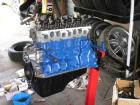Contents |
A-series Nissan Engines
The A14 and A15 engines are "tall deck" engines, and are 3/4 inch higher than A12s. However, they fit in the 1200 with only minor changes. This also applies to the 1974 A13 engine. The A14 and A15 are by far the most popular swapping candidates since the bigger displacement of the A14 and A15 means both more power (peak HP) and more low-speed power (torque) than the A12, A13 or A12A.
Like all 1974-up engines. the A14/A15 have the motor mount bosses in a different place compared to the 1971-1973 A12 engines. So the engine mounts are a bit different. This photos illustrates the difference:

Stock left-side mount in Datsun 1200, but Newer A12 engine. A better way is to move the brackets on the engine, to get the engine lower. You could also 1) use the 1974-up ute crossmember or 2) modify the crossmember. For more details, see Fitting Datsun A14 & 15 Engine
Discussions
- cheater_5 wrote up a detailed conversion here: Cheaters a15 into 1200 conversion
- An A14 installation Mildman undertook has been quite significantly detailed at the following web link. (Check the A14 Installation links)
- There is also a technical article at the datsun1200.com site that discusses this installation too.
What's Better? A14 or A15?
It depends on what you mean by 'better':- A14 often have better availability, meaning you can find one at an inexpensive price. <li>A15 has 7% more capacity than the A14, meaning an automatic power increase in low and mid-range RPMs, all else being equal
<li>A14 and A15 stock bottom ends can both rev to 8,500 rpm so there's no advantage there. With modified short blocks, both can rev to 10,000 rpm<li>Since both use the same cylinder head, there is little top-end power advantage with either engine (both will put out the same top-end power, but the A15 has additional power at lower speeds)</ul>
Remember: "There is no replacement for displacement" (aka "theres no substitute for cubic inches").
But isn't the A15 stroke to long to rev high?
If you drive an A15-powered car, you will see the tachometer rev up. No worries. A long stroke determines fast wear occurs at a given RPM. But with even longer stroke Chevrolet smallblock V8s running at 10,000 rpm, the A15 stroke looks small by comparison. A15s could rev even higher, but just like the A14 would need special valve train modifications and a scavenging oil pump with dry sump to make it worthwhile. Since A14s and A15s run the same cylinder head and valve train, maximum horsepower is for all practical purposes equal. All things being equal, with both the A14 and A15 using the same well-prepared and flowed cylinder head, they'll make the same top-end power.Rod length-to-stroke ratio
A long rod-length-to-stroke ratios is more efficient. To get this, you need longer rods to match a longer stroke. However, A14 and A15 use the same length rod. From previous discussion, an optimal rod-to-stroke ratio is good for about 1% power. The A14 doesn't have an optimal ratio but would need a longer rod itself. But either way the A15 is 7% larger displacement across the entire RPM range.

![[Datsun 1200 encyclopedia]](/wiki/upload/wiki.png)


